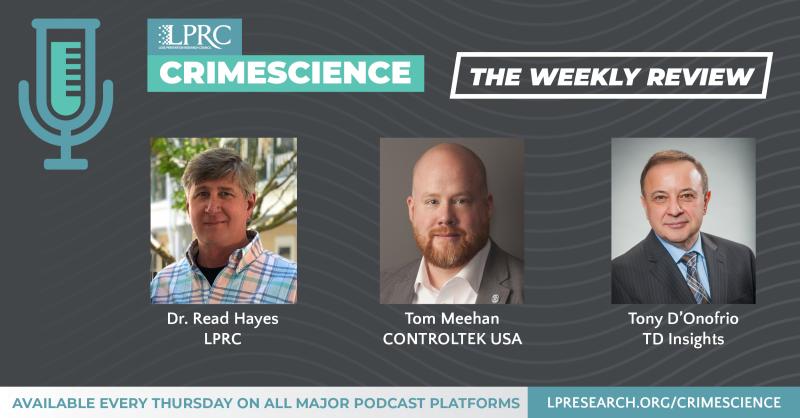Loss Prevention Research Council Weekly Series - Episode 66 - Highest vaccinated USA states and Retail Return Rates
With Dr. Read Hayes, Tony D'Onofrio, and Tom Meehan

LPRC IMPACT 2021 is In-Person from October 4th to the 6th! Product Protection Summit is Ready to Go! In this week’s episode, our co-hosts discuss these topics and more, including Vermont is Leading the Vaccine Drive, UN Reports 1.3 million die from road accidents, Connected Cars are Coming, and Return Rates are Increasing. Listen in to stay updated on hot topics in the industry and more!
The USA States Closest to Full Vaccination
https://www.statista.com/chart/25239/share-of-residents-in-us-states-who-are-fully-vaccinated-against-covid-19/
As of July 4, 2021, 172 million people in the U.S. (67 percent of the adult population) have received at least one dose while 156 million (46 percent) are fully vaccinated.
Vermont currently leads the U.S. by share of inhabitants fully vaccinated. According to the latest figures around 66 percent of its inhabitants have received both doses (or the single dose of Johnson & Johnson). Massachusetts, Maine and Connecticut follow with full vaccination rates of at least 60 percent or higher.
The lowest vaccination rate is in the US is Mississippi with nearly 30% fully vaccinated. Close behind in lagging is Alabama at nearly 33% and Arkansas and Louisiana at roughly 35%.
Global Happiness Levels in 2021
https://www.visualcapitalist.com/mapped-global-happiness-levels-in-2021/
North America’s current mood is happy. The average is nearly 11% higher that the global average. Canada retains its spot as the happiest country in North America, although its overall global ranking has dropped over the years. In 2019, it was ranked in ninth place globally, dropping to 11th in the 2020 edition, and declining further to 14th place in this year’s report. USA has a score of 7 and is the most improved country in North America. The unhappiest country in North America is Haiti.
South America’s mood is just content and is 7.3% higher that the global average. The happiest country is Uruguay. Brazil is close behind. The unhappiest country is Venezuela.
Europe’s Current Mood is Happy and 16% higher than the global average. Finland is the happiest country and is ranked number 1 in the world. Unhappiest country in Europe is Ukraine.
Middle East’s mood is complicated. The happiest country is Israel. The unhappiest country is Afghanistan.
In Asia Pacific, the mood is neutral. New Zealand is the happiest country. The least happy country is India.
The mood in Africa is unhappy. The happiest country is Mauritius and unhappiest country is Zimbabwe.
Why the Future for Cars is Connected
https://www.weforum.org/agenda/2021/07/why-the-future-for-cars-is-connected/
The market for connected cars is predicted to be worth over $215 billion by 2027. With the demand for greater connectivity set to soar, 5G-enabled connected cars will become the new norm.
Connected cars have clear benefits, being potentially safer and less harmful for the environment. They also present the car industry with an opportunity to innovate and create stronger relationships with its customers than ever before. 5G connectivity is the future of the auto industry and will redefine mobility as we know it.
Safety is an important factor. According to the UN, approximately 1.3 million people die every year as a result of road traffic accidents, with 20-50 million suffering non-fatal injuries. Over half of all deaths are vulnerable road users, such as pedestrians and cyclists.
Connected cars improve consumer experiences. According to McKinsey, 40% of consumers would change car brands just to gain more connectivity within their vehicles, rising to 61% for drivers in China.
Shuttered fitting rooms anger shoppers and boost returns. How these retailers are trying to fix that
https://www.cnbc.com/2021/07/06/retailers-try-to-solve-the-fitting-room-dilemma-as-online-sales-grow.html
A survey from Coresight Research found that 42.4% of consumers in the U.S. returned unwanted products from March 2020 to March 2021, and most of that was clothing.
Consumers returned roughly $428 billion in merchandise last year, or about 10.6% of total retail sales in the U.S., according to a study by the National Retail Federation. Clothing made up about 12.2% of that, the NRF said, adding that for every $1 billion in sales, the average retailer incurs $106 million in merchandise returns.
A big challenge for retailers are closed fitting rooms which are increasing the number of returns especially in apparel.
Retailers are now turning to new technologies such as 3D imaging of the body to provide size recommendations. Multiple startups are coming into this space.
One of the biggest votes of confidence in virtual fitting-room technology has been from Walmart, which in May announced it would be acquiring the Israeli start-up Zeekit, in a bid to better cater to customers shopping its website for apparel.
When Zeekit’s technology is embedded on Walmart’s website, customers will be able to upload photos of themselves — or choose from different models that represent their height, shape and skin tone. The site will then show how clothes will fit.
Zeekit has said that its virtual fitting rooms cut return rates by 36%.
Deloitte: Back to School Spending will be the highest level in years.
https://chainstoreage.com/deloitte-back-school-spending-will-be-highest-level-years
The retail industry is set for its biggest back-to-school shopping season in recent years as parents and students look forward to returning to classrooms after more than a year of virtual learning.
Spending is expected to reach $32.5 billion (for K-12 students), or approximately $612 per student, according to a forecast from Deloitte LLP. This represents a 16% increase from 2020 and is also greater than pre-pandemic levels.
(Another $26.7 billion will be spent by back-to-college shoppers, or approximately $1,459 per student.)
Overall K-12 spending will increase across categories, with 40% of K-12 households planning to spend more on back-to-school items (up from 22% in 2020), including clothing, supplies, computers and electronics.
Spending on technology products (personal computers, smartphones, tablets, wearables, etc.) is set to increase 37% over 2020 to $11.8 billion, as parents adjust to the realities of a more digitally oriented education system. Wearable technology will see the biggest gain.
















